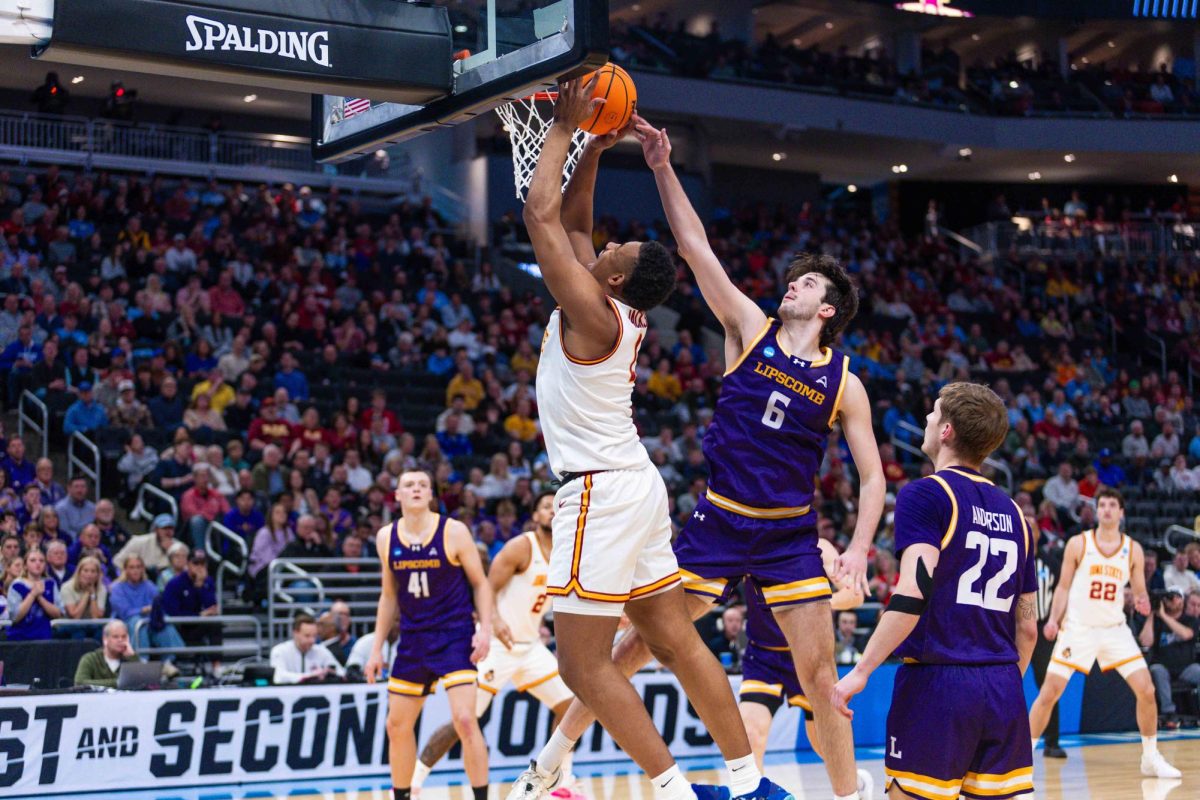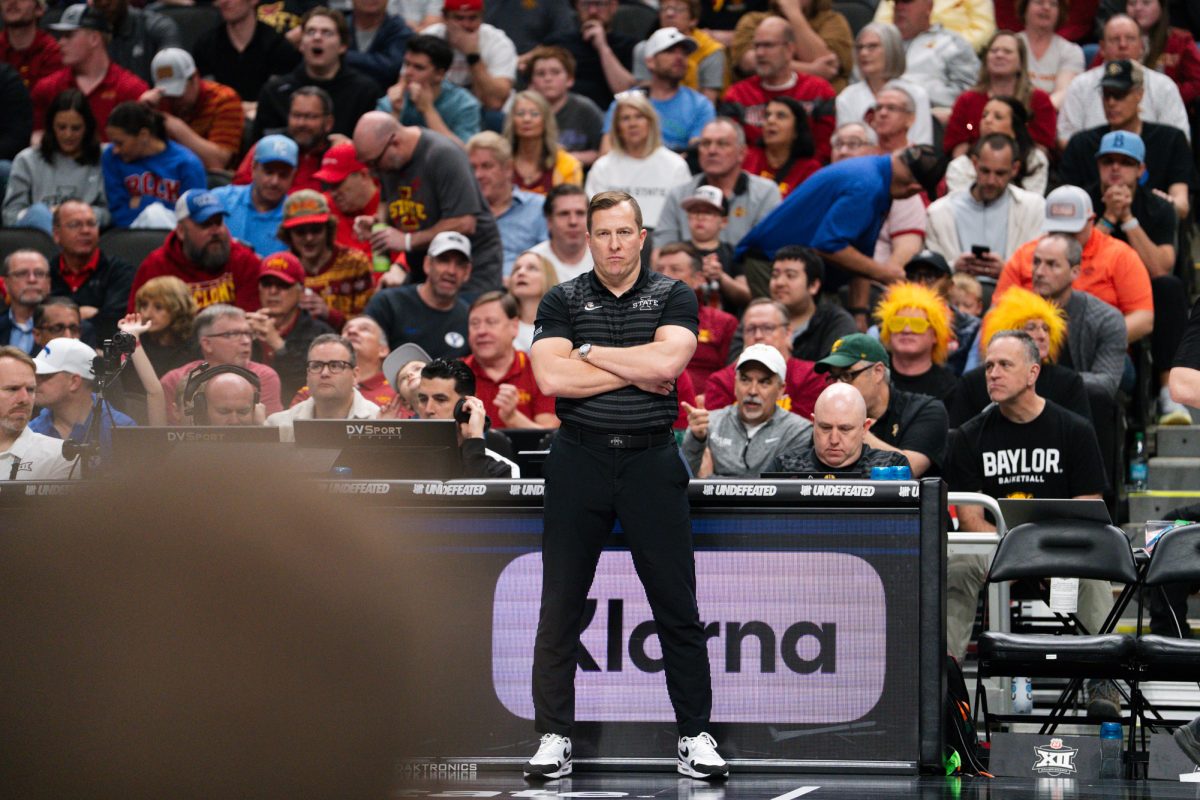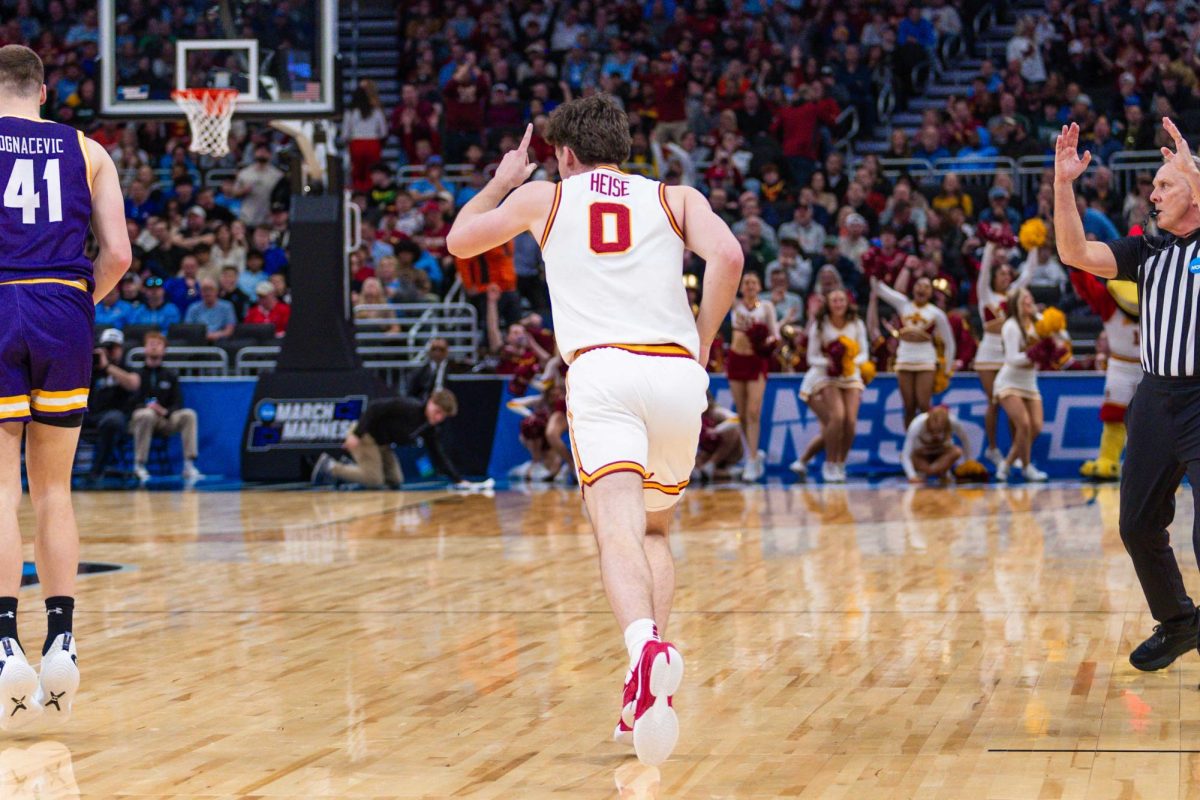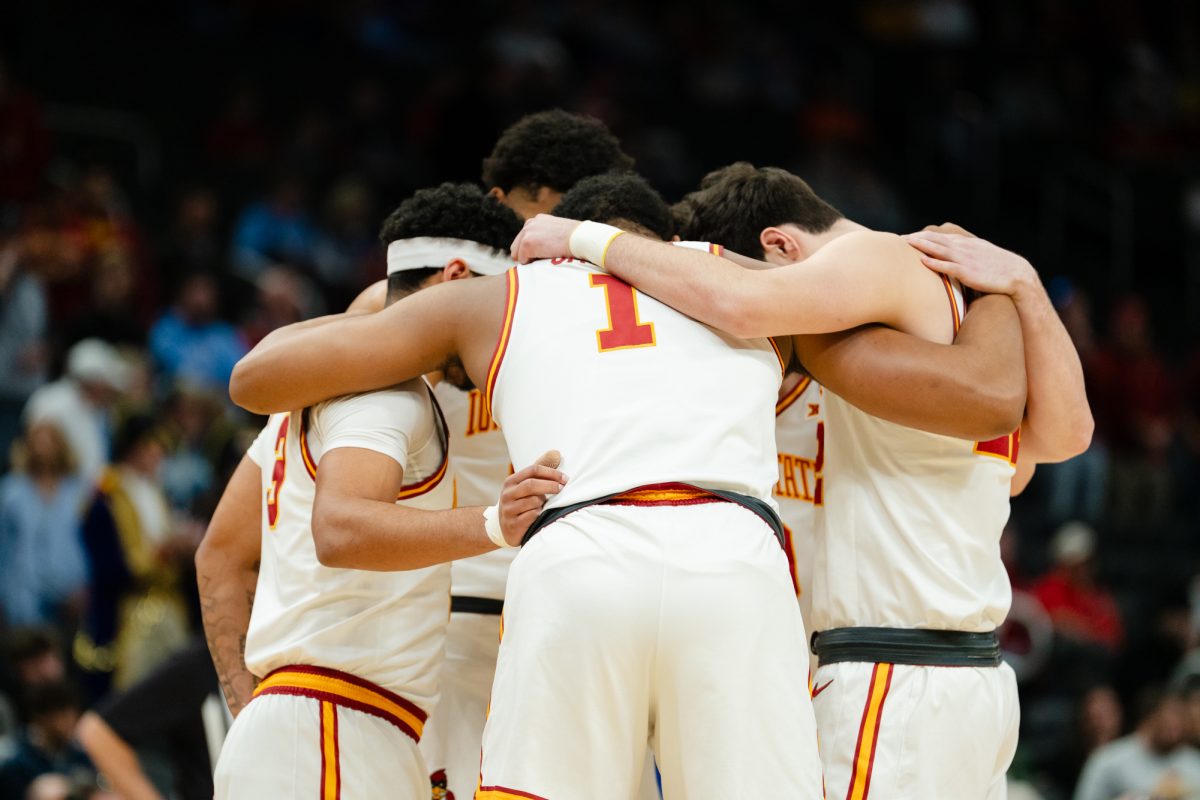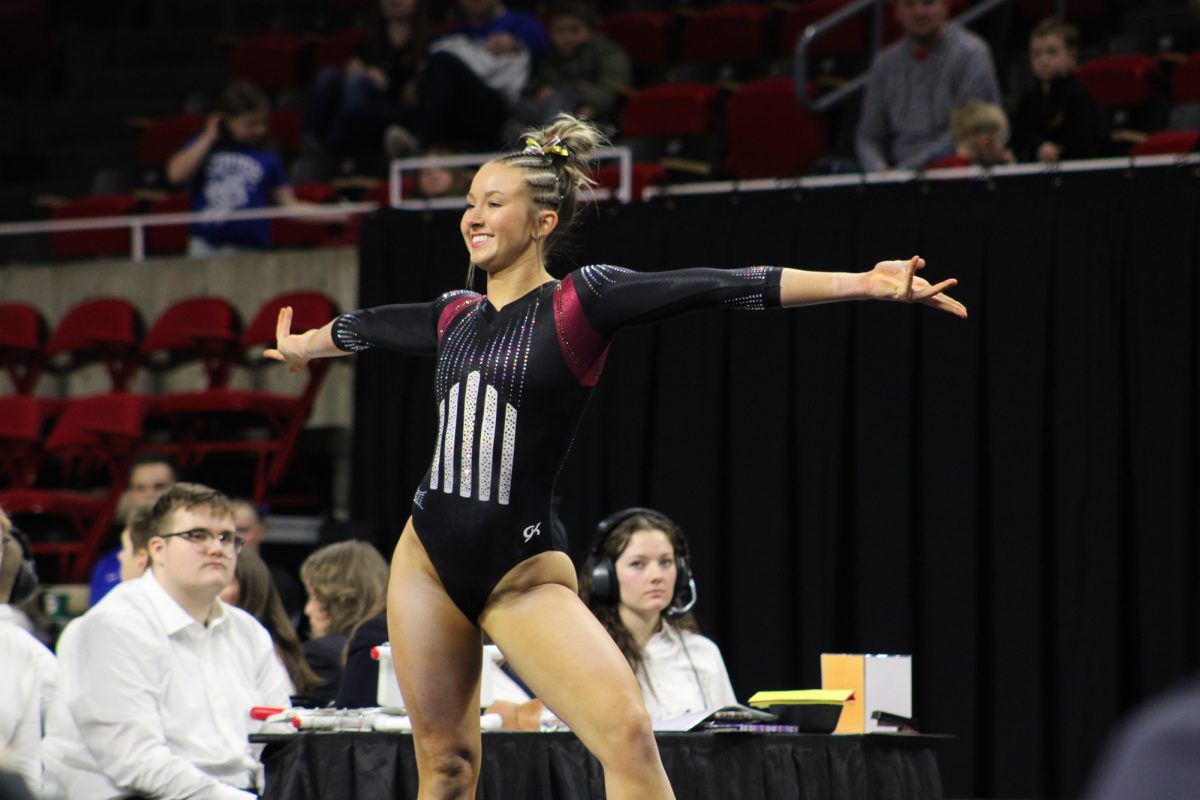Taking hits and taking names: the story of Skunk River Riot
Emily Blobaum/Iowa State Daily
Members of the Skunk River Riot run through a jam during practice Jan. 13. The team’s first bout of the year is against the Rockford Rage Jan. 23.
January 21, 2016
In the United Community School District, located just less than 10 miles from Iowa State University’s campus, one team has found a place to set its roots.
Now, it’s all about digging in the heels and getting bigger and stronger.
On Sunday mornings, women charge into a fierce competition, throwing all of their weight and strength to accomplish polar opposite goals.
Suddenly, the whistle blows, and everything stops.
Hearts pounding, lungs working deeply, the athletes disperse and return to the center. A few of them are laughing, clapping each other on the shoulders in a job well done.
This, of course, is roller derby.
Skunk River Riot is the only team under the Ames Roller Derby Association, which was formed within the last five years. The team competes during the spring and summer and trains during the remainder of the year. Last season, Skunk River Riot competed against five other regional teams.
Currently, the team is in the talks to play against much larger teams, including the Windy City Rollers based out of Chicago.
However, its schedule lists five upcoming bouts. Skunk River Riot will face off against Quad City Rollers on March 26 in the Quad Cities. Its only home game will take place against Southbond Rollers at 6 p.m. April 16 in the Boone Armory.
Before founding her own roller derby association, Mindy Kimball-Gerritson drove from Ames with her wife and another friend to practice with the Des Moines area team, the Des Moines Derby Dames. Kimball-Gerritson, whose derby name is Torque & Mindy in reference to the Robin Williams classic, said she created the association after spending so many hours in the car driving to practices and matches.
She said her car of teammates, including her wife Austin “Homewreck-Her,” had often talked about forming their own organization. They had even gone as far as to pick the name Skunk River Riot.
“Then one day we said, ‘let’s sit down and see if we can actually do this,”’ said Kimball-Gerritson, who is serving as the current coach of Skunk River Riot. “And then we did.”
Observing from afar, the sport appears different from the stands than on the rink. To a viewer, the game is wild, fast-paced and unchecked. However, the competitors are held to a strict set of rules and regulations. Blockers are not allowed to use arms when blocking a jammer; jammers cannot purposefully harm a blocker and must resort to their body weight or speed to avoid the obstacle.
When I first put on a pair of borrowed skates, I learned very quickly the most important lesson one must learn after donning a pair wheeled feet: how to stop.
But before that it was a lot of: ‘Hello wall, meet Michaela. Michaela? Say ouch.’
The first day was slow going — as in, I never really went faster than a brisk walk.
But the women there were patient with me and very encouraging. For my first hour, a woman called Spooky CastleVania or just Spooky, walked with me. She gave basic lessons on how to maneuver and how to avoid falling backward onto my backend. It’s more ideal to fall forward, where all of your padding is on the knees and elbows, and it helps avoid a tailbone injury.
Spooky was matter-of-fact in her instruction of the sport.
“Doesn’t matter how good or bad you are,” she said. “We all start out the same.”
When a woman joins roller derby, — even if she has had years upon years of experience — she is considered “fresh meat.”
Fresh meat is a term to refer to the newest members of the team. They are not allowed to hit, and, therefore, are barred from participating in matches. New recruits work their way to a full player status by mastering a series of skills, which a coach must sign off on. These skills include mastering three types of stops, turns and movements, as well as passing strength and speed tests.
Janine Tellinghuisen, also known as Booty Vicious, 55, said this sense of oneness from this position creates a camaraderie among the teammates.
“People here don’t beat each other down,” she said. “You come here and you’re empowered by your teammates because everybody had to start somewhere. So everyone has been in that fresh meat position.”
The speed of which people move through the ranks depends on their own skill, Spooky said. However, there is no pressure to move up at a specific pace.
One new recruit is within a hand’s reach of shedding the fresh meat status. Chloe “Brass Knuckles Bonnie” Williams, a sophomore studying pre-business at Iowa State, joined Skunk River Riot early on in the fall semester.
As a member of the National Guard, Williams said she was looking for a way to stay in shape. So, the 20 year old donned pink roller skates and knotted her hair in blonde pigtails under her helmet.
The first days were hell, she said. Derby is a sport that requires not only balance and coordination but strength and stamina.
“Learning to skate is kind of difficult. Your back muscles and your leg muscles start to get very fatigued,” Williams said. “You get tired and we just kind of start falling down and turn into a baby deer.”
However, she said the women of the team were encouraging — and nurturing even.
“There seem to be a lot of moms, which is nice because everyone is pretty nurturing and nice, but still very tough.”
Women, young and old, are welcome to join and be a part of ARDA. The majority of those involved skate, but there are some who serve the association in other ways. Desiree Dixon, or Tugboat, and Rita Mueggenberg, InstaGator, both in their late 50s, attend any practice they can. However, they do not don the gear and throw themselves in the ring. Mueggenberg serves as the treasurer on the board of directors, while Dixon helps the coach what she can at practices.
Mel “Melicious Mojo” May-Maxey, a local elementary teacher, is another player whose injury has halted her derby career; instead, she serves a variety of roles on ARDA as the secretary for the Board of Directors, as well as a member of the coaching committee and lead events committee.
A torn meniscus during practice put May-Maxey out of commission indefinitely. She said she had been going too hard at practice.
“I didn’t feel it, but I looked under my pad and my knee was the size of a baseball,” she said.
“I would love to get back on skates, but I don’t think it’ll happen,” May-Maxey casually added.
Injuries are a common theme among the team and roller derby nationwide. Dr. Cosette Scallon, associate director for clinical services at Thielen Student Health Center at Iowa State, said knees and ankles are the biggest cause of concern for these athletes.
“It’s a contact sport, so to be honest, it’s not really different from any other contact sport,” Scallon said. “There might be short-term and long-term depending on how bad you mess yourself up.”
Long-term effects from contact sports such as roller derby can have a major effect on the athletes. Scallon said the most likely result is arthritis in the joints, particularly in the knees and ankles. The lasting effects of a concussion also appear several years down the road, and Scallon said it has been known to negatively affect cognition, concentration and is correlated to depression, dementia and other mental health issues.
However, those in derby are pretty used to dealing with injury.
“We’ve got a lot of nurses on the team,” Mueggenberg laughed.
When Dixon broke the fingers of her right hand during practice, a teammate knew enough to place the broken fingers in her mouth and suck the rings off of her fingers before the swelling began. She said the doctors told her to thank whoever was smart enough to do that right away.
For the competitors, bruises were a sort of badge of honor. From the sickly greenish-yellow to the painful dark purple, they were all proud to show them off. Even the feared “skate rape,” a bruise sustained on a woman’s pelvic bone after another player skates over it, is a respected war story among the players.
Roller derby is a sport rooted in as much oral tradition as it is within solid history, but a movement that only gained momentum recently in the 20th century. John-Joseph Merlin is credited for creating the first recorded in line skate in 1760. However, it wasn’t until 1863 when American inventor James Leonard Plimpton patented the first “quad skate,” or a roller skate with four wheels set in two-by-two pairs. According to the Smithsonian Institute, Plimpton’s “rocker skates” were much easier and safer for users because they “allowed skaters to steer simply by leaning left or right.” Also in 1863, the first skating associations and skating rinks were opened in the United States, the Smithsonian stated.
The history of roller derby itself, however, is another aspect.
According to the ARDA website, roller derby was invented by Leo A. Seltzer in 1935. The sport boomed in the 1960s and saw a sudden decline a decade later. However, a choice few must have kept the faltering heart of the sport alive because there was a revival in 2001.
Today, there are 450 teams international and several associations across the world; ARDA follows the rules and regulations of flat track roller derby, according to the Women’s Flat Track Derby Association.
It’s even caught the attention of Hollywood.
“Whip It,” Drew Barrymore’s film released in 2009 starring Ellen Page that grossed over $13 million domestically, helped spark an interest among pop culture for a short period of time. However, for veteran derbiers, it was a disappointment.
“The movie “Whip It” gets a lot wrong [about the sport],” Kimball-Gerritson said.
“Except, there was one quote that sticks with me,” she continued. “At one point, [Ellen Page] says, ‘I am in love with this.’ That is so true for anyone who’s been here because you have to be in love with it to continue.”
Roller derby is booming, according to members of the ARDA, and it shows no sign of slowing down anytime soon.
ARDA itself has boomed as well. Initially, there were only three members at its founding. Currently, the local association has grown from one complete team.
However, the aspirations of the Kimball-Gerritson, the co-founder, do not stop there. She hopes to expand the ARDA beyond one team and to eventually have another competing team, as well as a men’s team and a junior league team for young adults and children.
During the practices, the sounds of skates on a waxed floor, shouts from women and the thuds of bodies colliding were not the only thing heard. Oftentimes, it was accompanied by the pitter-patter of small feet and squealing laughter.
“I mean, people bring their kids here all the time,” Crist-Wagner said, as the athletes began to shed their pads and round out their children. “It’s a really welcoming environment.”
Initially, walking into these practices, I had the natural but unfortunate stereotype of what a derby was, and what a derby girl would look like.
Within the short time of my first practice with the team, I was quickly correcting myself. There is no such thing as a typical derby girl.
Spooky told me this herself that first Sunday in the United Community School gym.
“You don’t always get this chance to be this kind of athlete,” Spooky said. “This is the only venue where you can take someone off the street and turn them into a superstar.”
There’s a place for everybody in roller derby, Spooky said. It is arguably the most inclusive sport for women in the United States.
There is a sense of confidence and strength women gain from donning a pair of skates and it’s evident in the way they carry themselves and interact with one another. At the practices, I observed very little of the self-deprecation women often inflict upon themselves; the phrases that include “I look fat in these pants” or “my stomach is so chunky.” If there was any, it was quickly shut down by their teammates, with words like, “shut up, you look so hot.”
Tellinghusen said the team thrives on support and camaraderie, as well as being happy with yourself.
“There’s a lot of being comfortable with the body that you have and how it’s so useful for the team, rather than trying to fit the mold of what society thinks you should be,” she said. “Here, it’s a value no matter what kind of body type you are. There’s a value for it on the team, so that’s really empowering.”
Feminine or masculine, strong or quick, there was a use for every body type or skill set. The sport is diverse, with a need for small and quick jammers as well as strong and tough blockers.
By the end of the third practice, I was feeling much more confident about my skills. I had even mastered the ski stop; it was a way to slow or stop yourself by widening your stance as far as possible and turning your feet inward. After I practically was doing the splits on skates for about an hour, the entire team gathered for laps — a drill in which I was able to participate. The goal was to skate as fast as one could around the track, with no stops within a five-minute period.
Honestly, it was exhausting. Nonetheless I did it, and it felt amazing to be able skate for an allotted period of time. Granted, I was nowhere near as fast as any of the veterans, but I would be lying if I said I didn’t feel any pride about not being the slowest in that gym.
Overall, I took a lot away from the practices. Even though the team was in its off-season, it was clear everyone was dedicated 100 percent to not only improving themselves, but the team as well. And everyone leaves a piece of their heart in their skates.
After the final practice, I found myself scrolling through the listings of athletic gear on Amazon. Finally, it popped up: one pair of black Pacer GXT-500 roller skates with pink laces: $79.



